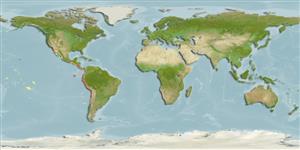Environment: milieu / climate zone / depth range / distribution range
Ekologi
laut bentopelagis; kisaran kedalaman 60 - 180 m (Ref. 5530). Tropical; 31°N - 34°S
East Pacific: Costa Rica, Colombia to extreme south of Chile. Records from Juan Fernández Is. are incidental (Ref. 89357). Records from Baja California, Mexico, Nicaragua and the Galapagos Islands are doubtful.
Length at first maturity / Size / Weight / umur
Maturity: Lm 26.9 range ? - ? cm
Max length : 54.5 cm TL jantan/; (Ref. 53696); Berat maksimum terpublikasi: 2.5 kg (Ref. 53696)
Occurs in schools (Ref. 5530). Known from a temperature range of 14-16 °C (Ref. 9098). Also caught with trammel nets (Ref. 9342). An appreciated food fish in Peru (Ref. 9342).
Also Ref. 103751.
Heemstra, P.C., 1995. Serranidae. Meros, serranos, guasetas, enjambres, baquetas, indios, loros, gallinas, cabrillas, garropas. p. 1565-1613. In W. Fischer, F. Krupp, W. Schneider, C. Sommer, K.E. Carpenter and V. Niem (eds.) Guia FAO para Identification de Especies para lo Fines de la Pesca. Pacifico Centro-Oriental. 3 Vols. FAO, Rome. (Ref. 9342)
Status IUCN Red List (Ref. 130435: Version 2024-1)
ancaman kepada manusia
Harmless
penggunaan manusia
Perikanan: komersial
Alat, peralatan
laporan khas
muat turun XML
Sumber internet
Estimates based on models
Preferred temperature (Ref.
123201): 11.5 - 17.1, mean 15 °C (based on 41 cells).
Phylogenetic diversity index (Ref.
82804): PD
50 = 0.5020 [Uniqueness, from 0.5 = low to 2.0 = high].
Bayesian length-weight: a=0.01047 (0.00557 - 0.01970), b=3.05 (2.89 - 3.21), in cm total length, based on LWR estimates for this species & Genus-body shape (Ref.
93245).
Trophic level (Ref.
69278): 4.1 ±0.5 se; based on diet studies.
Daya lenting (Ref.
120179): sedang, Waktu penggandaan populasi minimum 1.4 - 4.4 tahun (tm=2).
Fishing Vulnerability (Ref.
59153): Moderate vulnerability (42 of 100).
Climate Vulnerability (Ref.
125649): Moderate vulnerability (40 of 100).
Nutrients (Ref.
124155): Calcium = 73.7 [31.6, 146.4] mg/100g; Iron = 0.827 [0.437, 1.547] mg/100g; Protein = 17.2 [15.4, 18.9] %; Omega3 = 0.259 [0.147, 0.451] g/100g; Selenium = 71.9 [38.6, 155.3] μg/100g; VitaminA = 46.2 [16.4, 151.5] μg/100g; Zinc = 0.915 [0.631, 1.330] mg/100g (wet weight);
